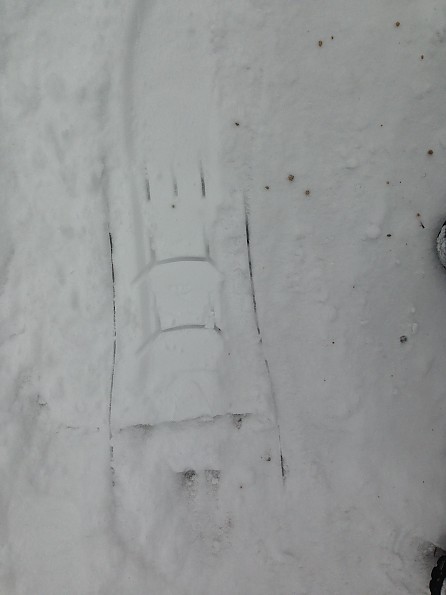MSR Women's Revo Ascent

MSR has created a good all-around 'shoe which uses spans from a beginner to a serious snowshoer. Its flex, fit, grip, and heel lift bar create a solid product for those who want a tough, wide ranged product.
This 'shoe works really well in a casual capacity, but is easily capable of handling hilly terrain or a serious excursion of a more dynamic trip. These shoes are an excellent choice for the novitiate who wants to grow to for the more experienced outdoor adventurer who needs a reliable, sturdy, all-terrain shoe.
Pros
- Really comfortable
- Good flex
- Good multi-use
- Tough
- Grippy
- Effective heel lift bar (Televator)
Cons
- Expensive for a casual user
- Have to seat the boot sole squarely aligned in the four straps, or things can rub or ride wrong
- Attending to four straps can feel time-consuming
MSR has struck a sweet spot in an effective, tough snowshoe that should suit a broad range of users.
Per MSR's website:
- 22 IN
- Color: Purple
- Weight per pair: 3 lbs 14 oz / 1.76 k
- Width: 8 in / 20 cm
- Length: 22 in / 56 cm
- Binding type: PosiLock
- Televator: Yes
- Gait: Women's/narrow
- Footwear size range: 4.5 W - 14 W / 35.5 - 48
- Load:Up to 180 lbs / Up to 80 kilos
- Load w/ tails: Up to 240 lbs / Up to 109 kilos
- Country of Origin: Made in the USA of US and Imported Parts
Ease of Use:
MSR employs a four rubber strap designs that makes the snowshoe “one” with the wearer’s boot. I was amazed and impressed that no matter how hard I pushed the 'shoes uphilling, downhilling, sidehilling, or walking on completely uneven terrain, the shoeshoes never felt loose, sloppy, or slippy on my boots.
MSR says: "Women’s PosiLock AT bindings create our most secure, freeze-resistant attachment for smaller footwear."
Like any ‘shoe, it takes a bit of practice to dial in the fit to the wearer’s boot/foot size, but the straps are simple to use.

The fine-tuning fitted perfectly over men's size 7 Danner Light Hikers
I really like how once these straps are fastened, they stay put. I have used other brands’ snowshoes, and I find I am often stopping to re-fasten the straps because they slipped loose. These straps are *just* the right length to be easy to use while wearing gloves, but not being too long to cause flopping. I found the clips be very effective at holding the loose ends snuggly out of the way, even when the shoe was being heavily used.
Thus these straps do not work loose. Once adjusted, they stay adjusted. I really like having the four strap system because I can absolutely dial in the fit to me. But like I mentioned in the summary, make sure the sole of foot is square on the shoe. The straps are aligned on the sole-plate so they naturally ergonomically cup the boot to encase it, holding it utterly secure. The straps also never stiffened or iced up in the cold.
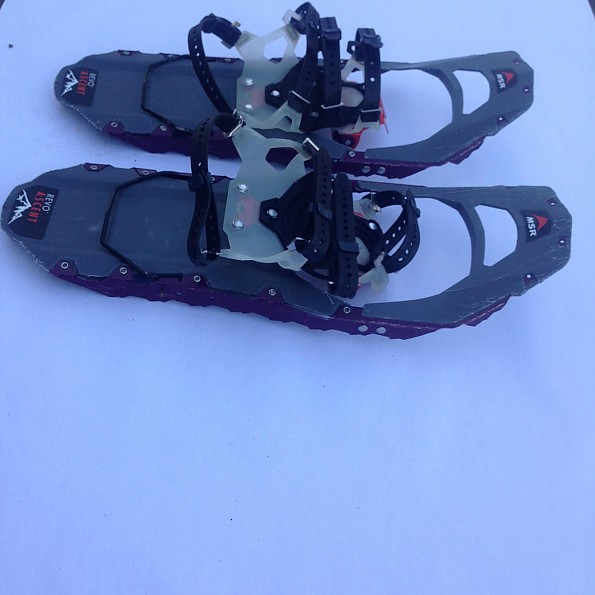
Well-placed, well-designed straps
The Televator is also really simple to use as well. When wanted, reach down with the handle of a snow shoe pole, and flip it up. When finished, lift the heel, and pop the Televator with the pole handle to snap it back down.
Features:
The Revo has excellent traction. The pivot cleat is split to adjust to uneven terrain for a smoother ride. The combo of the plastic deck outer frame gives exceptional torsion and strength.

Note the aggressive pattern and deep cleat bite; also note the excellent pivot
The gripping power is almost overbuilt. The pivot cleat is not only split, but provides a deep bite (the cleat runs about 1.5” long). The exo-frame teeth look like they were based on a chainsaw blade. The plastic decking also has a series of fins beneath that add to side-hilling stability.
Even with the additional fins, snow does not clump and hold the base of the snowshoe at all. I have had ‘shoes where I had five pounds of snow hang on and add weight. Not these. These ‘shoes also do not flip snow to wet the trousers of the wearer.
The Ergo Televator is a nice feature that not only reduced fatigue, but also contributed to the comfort of climbing steep slopes. I intentionally found the steepest slopes, pushing 30-35 degrees, so I could to push the effectiveness of the Televators and the traction. I was pleased that the Televators angle put my foot in position to increase the effectiveness of each step on the slope. I was naturally thrown a little forward, putting my weight over the grippiest parts of the ‘shoe.
A sample look at the angle of the Televator
The size and design are also very comfortable for my female stride. I am 5’4” with a 30” inseam. In normal walking conditions I never stepped on the other shoe, and my hips never hurt from having to use an unnatural gait. The snowshoes also did not particularly flip snow up from behind.
The only thing I notice is that because the pivot works so well, that I had a hard time backing up, because I did have to lift my foot so high to get above the snow. But I found that constraint to be quite minor.
Even with the heel bar and extra strap, each 'shoe weighs in at *just* under 1.7 pounds.
They are also not terribly noisy. While no modern snow shoe is completely quiet, these are discernibly quieter than an all plastic design.
Construction & Durability:
I punished the shoes the first time I used them. I took an eight mile trek Priest Lake, IDdaho, in about eight inches of powder. The rough shoreline was a terrific test of the torsion, grip, and durability of the plastic decking, the steel frame, and rubber strapping. Outside of scoring of the plastic deck, scraping a little paint off the cleats, and some discoloration from initial deformation of the pressure caused by stepping on large rocks, the ‘shoes are in great condition.

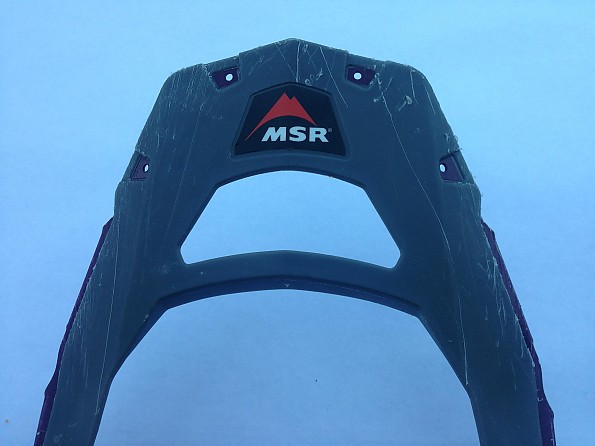
Scuffing on the tops of the snowshoes
Deformation marking on the deck; scuffing on the tail from hard use
I have always been told not walk on bare ground with snowshoes, but with the high end construction and materials, I am not panicked about doing great harm to the materials if I have to deal with a bare patch. I am just careful about picking my steps.
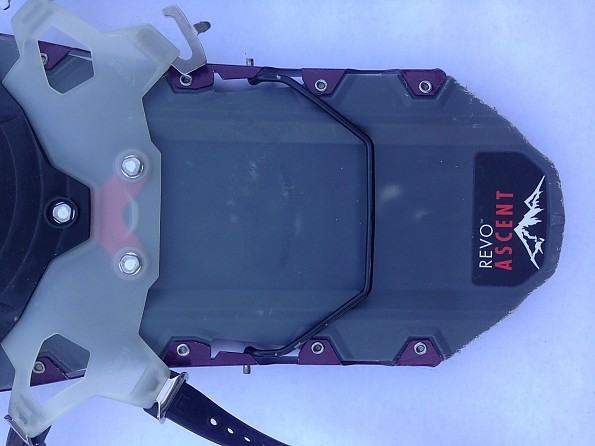
The plastic turned white after I had stepped on snow covered rocks on the shoreline
Conditions:
The ‘shoes have been used on the shoreline of Priest Lake, Idaho; Mount Rainier, near Paradise in the “Cascade concrete” of the really wet snow conditions we have had all winter; and on Chinook Pass, in the wetting out powder the pass received late spring.
As noted earlier, Priest Lake had about eight inches of fresh powder her shores on the day of my outing. I went about four miles along the shoreline, encountering the challenges of the rocks beneath the 'shoes. The flexing and grip really made the trekking stable, while eliminating the slip and hard work navigating slippery fresh powder.
I did find a little powder to try on Rainier, but it was on a really steep hillside. The ‘shoes perform pretty typically in powder for their size. Unfortunately, with the poor snow conditions of the Cascades this year, I am unable to give any better report of their use in deep powder. 
On Rainier — no real issues traversing the hill in either direction
I carried my winter day pack on both Priest Lake and Rainier; it tops out at about 15 pounds. I didn't notice the pack being any sort of an issue while snowshoeing. The 'shoes handles the combined weight of me and it perfectly.
While at Chinook Pass, I really pushed the uphill traction of the ‘shoes. It was about 65 degrees the day I visited, and the place was crawling with people. Therefore, I traversed where people had been hiking in just shoes or boots. Their walking created deep track and post holes that I intentionally navigated over. The shoes performed excellently. The flex and grip made me feel really comfortable walking over the choppy trail.
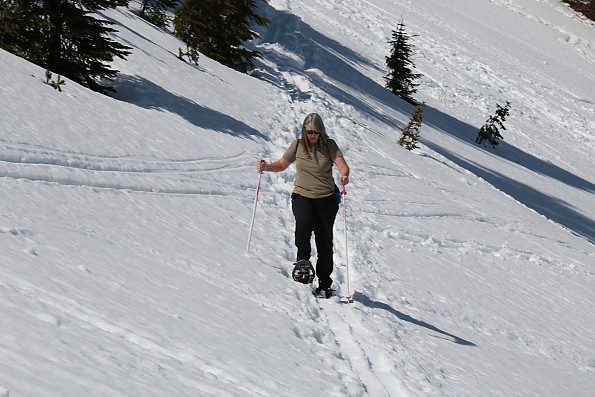
Over really choppy trail -- the flex made the shoes ride almost like I was on untouched snow
In pushing the features of the ‘shoes, I picked out wet, almost fluffy snow (yes, it does exist!), and I did get bogged down a couple times in going straight up the 30-35 degree hills. The conditions were not typical of the normal snow season, and the slipping and bogging down was nothing that I and the snowshoes ultimately couldn’t handle.

The wet snow made conditions quite slippery. The shoes handled the conditions reasonably well.
Even in the fluffiest of snow, I found I never sank past about ankle deep with the float of the deck. It is on par with other shoes of similar size. I felt the float was appropriate for the size and design of this snowshoe.
A word about down-hilling – Since I went up, I also navigated down equally steep slopes. This is where I had the most trouble. Because all of the deep traction is on the front of the shoe, and very little on the back, I did slip and land in the snow a handful of times. I think this is important to note since these shoes are intended to work well while climbing, hence they should have more aggressive traction in the back for down-hilling.
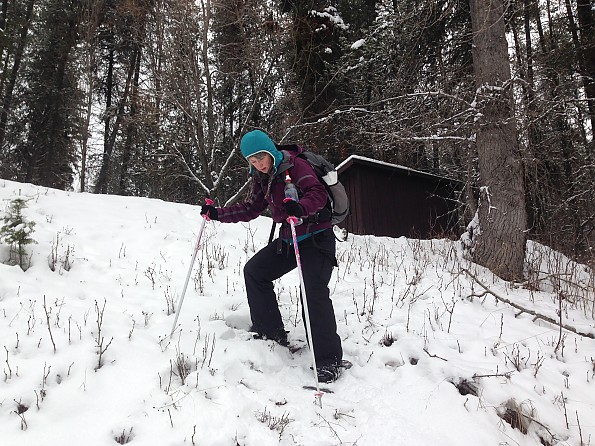
Pushing the grip on a slope in the powder
They are better in the side-hilling descents, but I still struggled with slipping and sliding on the very steepest parts. I did try glissading down a particularly steep slope after a slip, but because the pivots work SO well, I couldn’t lift my ‘shoes out of the snow to slide. I tried this technique for the purposes of testing for this review, but honestly, I would rarely take such steep descent approaches on a typical day.
All I had with me that day was a little string pack that I wound up over-loading. It was flopping all over as I was negotiating my testing; it continued to yank and pull me around; with every step, the 'shoes held firm, even on the steep hills. The effectiveness of the traction was obvious with my loose load.
A few years ago, I rented a pair of snowshoes that I really liked, and subsequently have rented often. After this last outing, my husband asked me point-blank which pair I preferred. And as much as I like the other ‘shoes, I have to say that the Revos are a really terrific product; the features of the flex, fit, grip, and Televators have elevated these snowshoes as my new favorites.
Source: received for testing via the Trailspace Review Corps
(Sample provided by MSR for testing and review)
The Women's Revo Ascent snowshoes are designed to stand up to any kind of terrain. They're durable, easy to use, and have a narrow design for your convenience.
Pros
- Narrow
- Easy to use
- Comfortable
- Heel adjuster
- Great quality
- Rugged design
Cons
- A bit pricey
Finding the best outdoor gear to get you through the winter can be a challenge. Snow complicates everything. But Mountain Safety Research's Revo Ascent snowshoes lessens the headache. By providing a high-quality, durable snowshoe that can tackle any terrain, MSR prioritizes experience over profit. And they believe in their products, so you won't ever end up purchasing an MSR product that can't be corrected.
MSRP: $259.95
Weight Per 22" Pair: 4lbs 2oz
MSR is known for designing high-quality gear and the Revo Ascent snowshoes are no exception to this rule. The deck is made out of nylon, and the frame is made out of aluminum in order to guarantee long-term use. Without tails, the 22-inch version of these snowshoes is capable of holding 180 lbs.
The main point of investing in a snowshoe is to find a device that offers traction and flotation. And the Revo Ascent snowshoes do just that. By pairing lightweight efficiency with durability, these snowshoes provide one of the most reliable designs on the market.
Construction & Durability:
Paragon Binding: The binding design on these snowshoes is great because it's made of mesh, which alleviates pressure on your boots. Additionally, the toe stops allow you to take confident steps. Rather than wondering if your snowshoes will catch you, the baskets allow you to move quickly and efficiently.
Add-on Flotation: If you find yourself in a lot of different winter conditions, the Revo Ascent snowshoes might be the best option for you. The adjustability on these snowshoes is unmatched by competitors and the add-on Revo flotation tails are part of what makes this shoe so great.
Cost: The only drawback I've been able to find is the cost of these snowshoes. Because they're made of such high-quality materials, they're a little on the steep side. If you're really committed to snowshoeing, the cost shouldn't deter you. They're worth ever penny. But there are decent snowshoes that can be found for less money.
Backcountry Testing: I was lucky enough to take the MSR Revo Ascent snowshoes into Colorado's backcountry on several occasions. These snowshoes performed incredibly well at altitude, on steep inclines and on flat ground.
After a five-mile Thanksgiving hike that involved a lot of post-holing, I found myself pleased with the performance of these snowshoes. My friend, who decided to tackle the terrain (while using nothing more than Microspikes) slid around a lot more than I did. The jaws on the bottom of these snowshoes kept me from slipping like he did. But on top of the traction, these snowshoes didn't collect snow on top of them like some competitive products. So, I didn't end up carrying extra weight around.
Final Thoughts: Finding traction devices that can get you through the gnarliest territory can be really tricky. But MSR's Revo Ascent snowshoes did an awesome job. I'd definitely recommend these snowshoes to anyone who's looking to invest into their winter lifestyle.
Source: tested or reviewed it for the manufacturer (Kept it)
![]() All Revo Ascent versions
All Revo Ascent versions
In addition to the 2 women's reviews above, there is 1 review for another version of the Revo Ascent. Read all reviews »
Your Review
Where to Buy
You May Like
Accessories: MSR Revo Tails,
Specs
| Price |
Current Retail: $319.95 Historic Range: $143.93-$319.95 |




